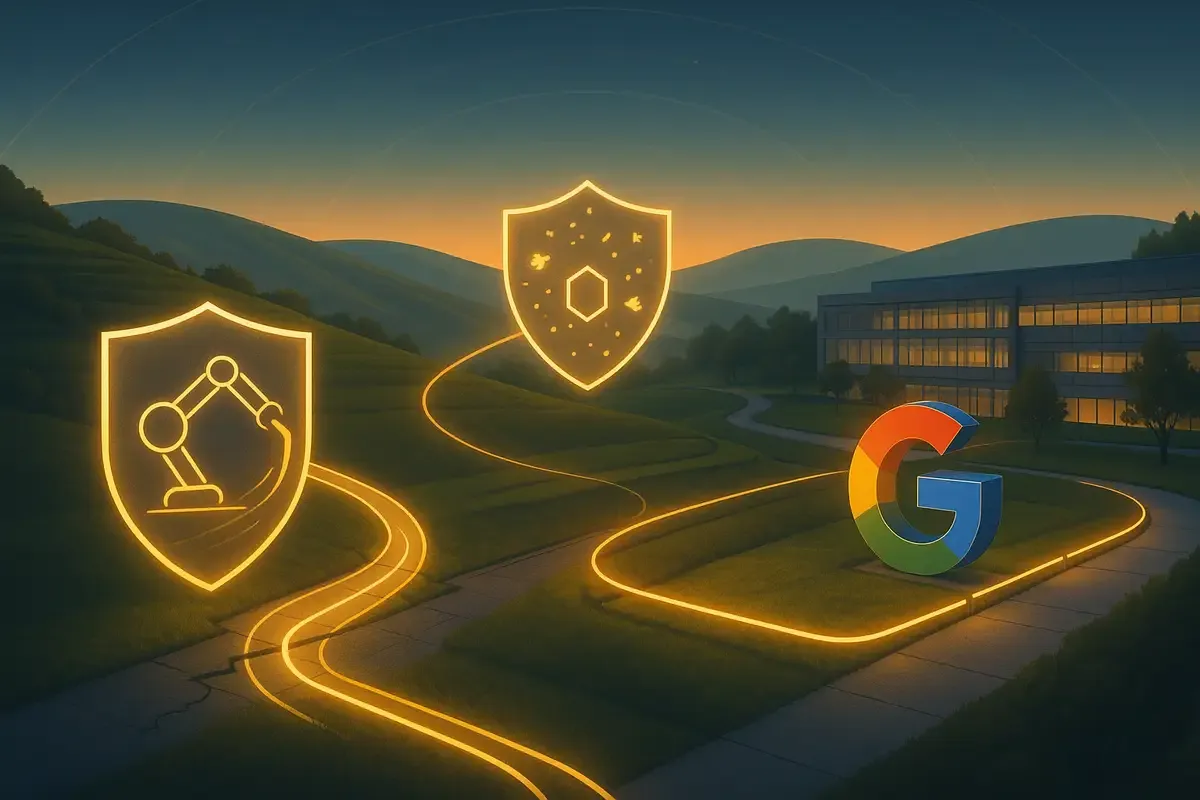Google dropped three security tools Tuesday, each aimed at the same bind: AI accelerates attackers faster than defenders can adapt. The answer, according to the company, is more AI—this time on defense. CodeMender auto-patches vulnerabilities. A dedicated AI bug bounty clarifies where to report what. And a revised Secure AI Framework maps risks when agents plan, decide, and act autonomously. The pitch is elegant. The execution will show whether automation can close the gap before the attack surface widens further.
The autonomy trade-off
Security teams can't keep up. Alert queues overflow. Dependencies multiply faster than anyone can audit them. Maintainers burn out. Now add AI agents that query databases, call APIs, and move data without waiting for approval. Every autonomous action is a potential failure mode. Prompt injection stops being a content problem and starts looking like privilege escalation. Data poisoning feeds bad decisions directly into action loops. Tool chains execute before anyone reviews the plan.
Google's bet is that the same capabilities creating those risks can also mitigate them. Automate the right parts, constrain the rest, and maybe defenders catch up. That assumes clean boundaries between what agents can do and what they should do. Reality doesn't cooperate. The boundaries blur under production load, and governance becomes the bottleneck automation was supposed to eliminate.
Key Takeaways
• CodeMender auto-patches vulnerabilities with multi-agent validation, upstreaming dozens of fixes across major open-source projects in six months
• New AI Vulnerability Reward Program separates security exploits from content issues, consolidating scattered rules into unified scopes and payout tables
• SAIF 2.0 maps agent-specific risks like prompt injection and rogue tool chains, formalizing governance principles for autonomous systems
• Success depends on quantitative proof: time-to-patch metrics, maintainer adoption beyond Google projects, and whether teams enforce privilege constraints
CodeMender: from flag to fix
Most security automation drowns teams in findings. CodeMender inverts that: it ships validated patches, not just bug reports. The system leans on Gemini reasoning paired with static analysis, dynamic testing, fuzzing, differential checks, and SMT solvers to locate root causes. A multi-agent workflow drafts a fix, routes it through "critique" agents that check correctness and side effects, then surfaces high-confidence changes for human review. Humans still approve the merge. No autonomous commits yet.
Over six months, the agent has upstreamed dozens of fixes across major open-source projects, some with multimillion-line codebases. The other capability is proactive hardening: rewriting code to safer APIs or adding compiler flags like -fbounds-safety to kill entire bug classes. That's prevention layered onto response. It's also unproven at scale.
What's missing: head-to-head metrics. Mean time to patch versus baselines. False positive rates. Regression counts post-merge. Until those land, CodeMender is a credible demo with safeguards, not a drop-in for maintainers. The validation loops are real—the agent auto-repairs test failures it introduces. But maintainer trust isn't won with clean diffs alone. Drive-by PRs from bots still get rejected in communities that prize context and conventions over code hygiene. Google's angle works if projects opt in. Forcing adoption through volume won't.
The bug bounty calculus
Bug bounties live or die on clarity. Google's new AI Vulnerability Reward Program consolidates scattered rules into one set of scopes and payout tables, while routing content-safety complaints to in-product feedback. The split is deliberate: security teams need exploitability evidence and model versions, not jailbreak screenshots. Unified lanes speed triage. Speed is survival when vulnerabilities compound daily.
📰
We read 100 articles. You read one email.
Five minutes. Zero BS. Daily AI news.
The company says it's already paid hundreds of thousands for AI-related findings and wants more volume. Two design choices matter. First, separating "security" from "content behavior" prevents the program from drowning in low-signal noise. Second, common rules across products reduce researcher guesswork. Clear incentives pull talent toward real threats instead of social-media theater. That's the goal. Whether payout tables match the effort required to find agent-specific bugs will show in submission rates and researcher retention.
SAIF 2.0: agent guardrails as governance work
If CodeMender is the tool and the VRP is the incentive, SAIF 2.0 is the playbook. The update acknowledges that autonomous agents reshape the threat model. They plan, call tools, move data, and act in the world. SAIF 2.0 formalizes three principles: well-defined human controllers, carefully limited powers, and observable actions and plans. It maps risks across the stack—prompt injection, data poisoning, rogue action chains—and donates that risk taxonomy to an industry coalition.
Shared maps don't fix bugs. They do keep teams aligned on language and control catalogs. The catch is governance. Defining who authorizes which agent capabilities, how powers are scoped, and how auditability works across thousands of agent actions isn't a technical problem. It's organizational. Logs and privilege checks are only as strong as the teams enforcing them. Google's framework is a start. Incident reports—or their absence—will validate whether it holds under production load.
The competitive positioning
Everyone is racing to automate remediation. Microsoft, GitHub, and multiple startups ship code assistants that suggest patches or open pull requests. Most stop short of end-to-end validation with multi-agent critique and formal methods. Google's angle is breadth: combine program analysis with LLM reasoning under a "secure by design" agent framework, then backstop it with bounty incentives. If it scales, the moat isn't a single model. It's the pipeline—validation, critique, and human-in-the-loop gates that let agents act without runaway risk.
That only works if developers trust the output. Maintainers aren't waiting for perfect patches. They're juggling bandwidth, legacy code, and contributor friction. A bot that generates clean PRs but doesn't understand project norms will get ignored. Google's track record with open-source contributions helps. Its brand doesn't guarantee adoption. Earned trust does.
Three tests ahead
Quantitative improvements matter first. Median time to patch for CodeMender fixes versus manual baselines. Regression rates. False positive counts. Those numbers will show whether automation actually shifts the curve or just adds noise. Second, adoption beyond Google-touched projects. Does the agent earn maintainer trust in diverse communities, or does it stall at the perimeter? Third, teeth in SAIF 2.0. Do agent teams at Google and partners actually cut privileges, log plans, and block unreviewed tool calls by default?
Show the diffs, not just the diagrams. Then we'll know if this is infrastructure or theater.
Why this matters:
• Defensive automation that ships validated fixes instead of findings is the only realistic counter to AI-accelerated offense at scale.
• Agent-security frameworks only matter if they constrain real deployments—governance is implementation, not documentation.
❓ Frequently Asked Questions
Q: What are SMT solvers and why does CodeMender use them?
A: SMT (Satisfiability Modulo Theories) solvers are formal verification tools that prove whether code conditions can be satisfied. CodeMender uses them to verify that proposed patches actually fix root causes rather than just symptoms. They catch logical bugs that fuzzing and testing might miss, especially in edge cases with complex state dependencies.
Q: How is the AI Vulnerability Reward Program different from Google's existing bug bounties?
A: The AI VRP consolidates scattered AI-related rules across multiple programs into one unified scope and payout structure. It separates security exploits from content-safety issues, routing jailbreaks to product feedback instead of bounty queues. This prevents security triagers from drowning in low-severity model behavior reports that lack exploitability context.
Q: What do CodeMender's "critique agents" actually check?
A: Critique agents are specialized reviewers in CodeMender's multi-agent workflow. They verify patch correctness against test suites, check code style compliance with project conventions, and flag potential side effects like performance regressions or API contract breaks. Only fixes that pass all critique layers reach human maintainers for final approval.
Q: What specific agent privileges does SAIF 2.0 recommend restricting?
A: SAIF 2.0 calls for limiting agents to read-only data access by default, requiring explicit approval for write operations or external API calls. It recommends blocking tool chains that mix high-privilege actions without human review, and mandating that all agent plans be logged before execution, not just results afterward.
Q: Will CodeMender eventually replace human security engineers?
A: No. CodeMender requires human approval for every patch it proposes, and Google explicitly designed it to augment maintainers, not bypass them. The agent handles repetitive validation work—running tests, checking style, verifying fixes don't break builds. Humans still make judgment calls on architecture, backward compatibility, and whether a fix fits project direction.








